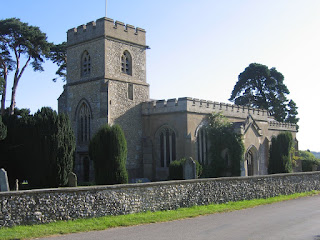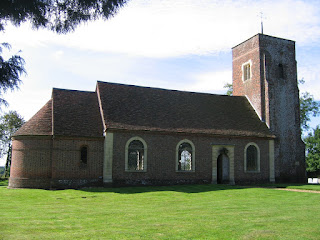Just as an aside, I've been trying to use the OnTheRoad service on the web to help plan my trips. I can add a trip description, select places on the map as 'stops' and add notes for these stops. The idea being that whilst out on the trip, I can then upload stories and geotagged photos for each place from my phone (Android and iPhone are currently supported). Unfortunately, having added the stops I wanted, and made notes on each of them (postcode for the GPS, points to look out for etc.) I could find no way to retrieve this information from the system again apart from re-editing each item individually on the PC. I couldn't see the information at all on the phone. It would be useful if I could have printed out a trip plan with all the stops and notes on it. Ah well, another request for the developers...
But this weekend, I've at last got something to report. Out of a total of seven churches visited today, two had evidence of the Green Man in different guises. And more importantly, I may have tentatively identified a Sheela figure which I've not seen listed previously elsewhere!
Aldbury St John the Baptist

The church in this picturesque village is just to the west of the village pond, which also features stocks and a whipping post.
The main attraction in the church is the spectacular Pendley Chapel in the south aisle screened from the rest of the church by a stonework screen. A wildman, or wild wose, clutching his club is reclined at the foot of Sir Robert Whittingham, builder of the nearby Pendley Manor. His wife lies alongside him, with a (battered) hind at her feet. The stonework apparently dates from the 1500's, and is particularly fine. The wildwose is of course a relative of the Green Man.
I have visited this church previously, but have yet to get a satisfactory picture of the wildwose, due to the lighting conditions and crampedness in the chapel.
There is also, on the north wall an old stone head corbel which provoked my interest. The head is quite damaged on one side, but the side remaining shows an arm looped under a leg. If this pattern were symmetrical on the other (damaged) side, then there's a possibility that this could be the remains of a sheela-na-gig type figure. The problem is that the figure would then be wider than the apparent width of the corbel itself. There is only brief mention of the corbel in the church guide, which suggests a 13th century date for the carving, but gives no other information.
So a mystery remains.
Little Gaddesdon, SS Peter and Paul
This pretty little church lies half a mile from its village, and contains several memorials to the Egerton family, who occupied the nearby Ashridge Estate in the 1700s. I'd arrived shortly after a service had concluded, and a couple of gentlemen were just locking up the vestry, but were happy for me to have a look around. When I mentioned my Green Man interest, they had little idea, and one of them stated as he was leaving that he knew of no such symbology in the church.
I was therefore pleased and surprised to find not one, but three foliated head images on a late stained glass window on the south wall, each similar but differing in very small ways from the others.




Sadly, the rest of the trip held no such finds, but I'll document the negative hits here anyway for completeness.
Nettleden St Lawrence

This church was locked when I arrived, though it has a magnificant avenue of 12 yew trees leading to from the road to the porch. The outside is rather plainly decorated, I've no idea if the inside will hold any treasures.
Great Gaddesdon St John the Baptist

A service was in progress when I arrived, but the church door was open, and I could see decorated capitals on the columns, so there may be some hope if I pass this way again in future. Externally the main points of interest here are the Norman gargoyles on the tower, and the proliferation of puddingstone, often used in prehistoric times to waymark paths and river crossings - the Gade flows nearby. There is a large lump of this stone in the churchyard to the south of the porch, and another on the north side. In addition, puddingstone has been used as a base for several of the buttress points on the north side. A similar practice of using such large stones has been interpreted in other areas as a 'stamping down' on previous pagan practices - see Pewsey church in Wiltshire as an example of this.
At this point, we crossed the border into Bedfordshire to check out the final three churches for the day:
Studham, St Mary

Preparations were underway for a service, and the place was full of some of the most fragrant flowers after a wedding the previous day. Sadly though, the stonework in the chancel is in dire need of repair work, which it is thought could take a few years to complete. After that, the tower will be in need of attention too.
The only item of any interest here, and the oldest item in the building, was the font. This contains a carving of some mythical beasts, a couple of which had florate tongues. Not quite a Green Man motif, but as close as I was able to get in this small church at the end of a countryside cul-de sac.

Whipsnade St Mary Magdelene

Quite simply, one of the plainest churches I've seen for quite some time. No south door, no porch, no stained glass. A service had just finished, so I poked my head in the door, having already looked through the plain windows. No decoration of any type. The church was built in the 1500s and updated by Hawksmoor in 1719. It could have been built by an anonymous 1960s council planner for all that I could see. Time to move on.
Kensworth St Mary

I didn't realise it at the time, but I was racing the vicar here from Whipsnade! Parishioners were arriving for the service as I got here. In my trip preparation, I'd noted that the main door has some interesting Norman carving, so I was hopeful. I tentatively entered the porch and took a couple of photos, but was spotted. A friendly gentleman invited me inside to take a look around before the service started. On mentioning my search, his response was 'Oh, that's a pub, isn't it?'
I explained briefly about the Green Man and he said he could show me a couple of heads which may be of interest in the tower, above what used to be the main west door. However, these were part of the original Norman stonework and not related to my search, sadly. He was quite friendly and interested though, even pointing out to me the scratch sundial inside the porch, a remnant from before the porch was built. He missed the more interesting fantasy beast carvings on the capital of the south door columns though...

The church also contained some decent memorial glasswork in the windows, and I took my leave just as the vicar was arriving. No point in becoming a captive audience, is there?
So a productive day's trip. A couple of decent hits and enough to keep my enthusiasm for the search up.
This post has definitely got me interested in writing these again, so look out for some 'catch-up' articles over the next couple of weeks, outlining the negative hits over the summer so far.


